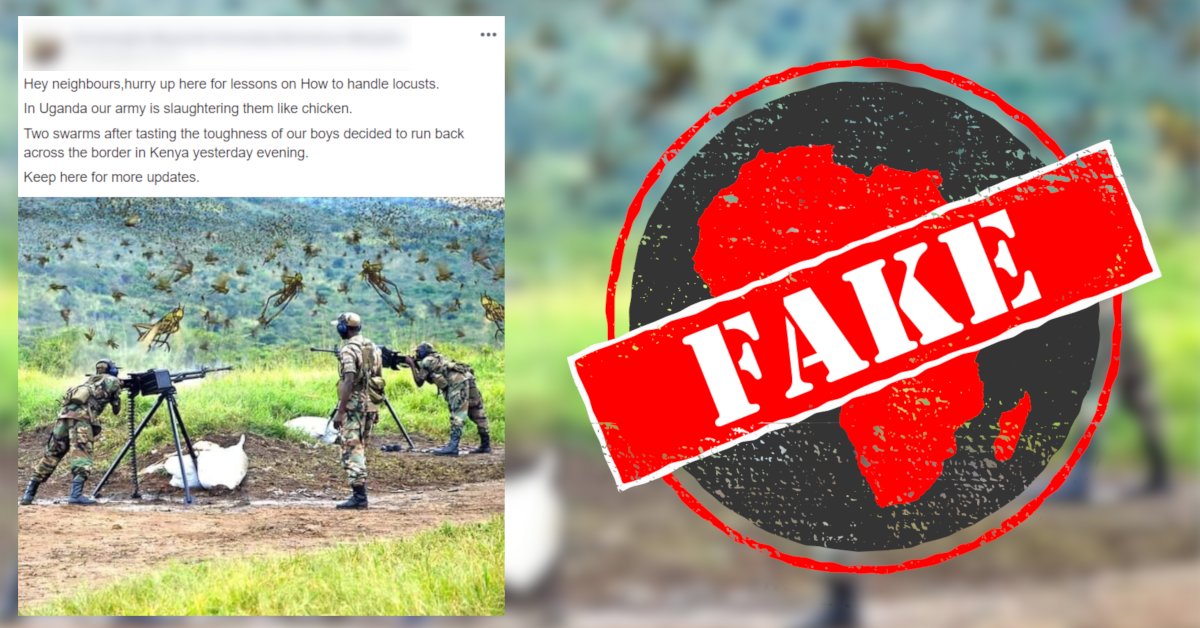An image shared on Facebook seems to show soldiers aiming machine guns at a huge swarm of insects.
“Hey neighbours,hurry up here for lessons on How to handle locusts,” the caption reads. “In Uganda our army is slaughtering them like chicken. Two swarms after tasting the toughness of our boys decided to run back across the border in Kenya yesterday evening.”
According to the UN Food and Agriculture Organization, locust swarms were reported in Kenya, Uganda, Tanzania and Somalia in February 2020, posing a threat to food security and livelihoods in the region.
There have been media reports that Uganda has deployed soldiers to help fight the locusts. But does the image show this? We checked.

A reverse image search reveals that the image has been manipulated to add the swarm of locusts.
The original photo first appeared online as early as 23 April 2009, on the US Africa Command website. It’s credited to Kenneth Fidler.
The photo shows Rwandan soldiers during a live-fire demonstration on 21 April 2009 in Gabiro, Rwanda. But there are no locusts.
The caption reads: “Rwandan Defense Force (RDF) soldiers fire machine guns scoring direct hits on targets during a live-fire demonstration April 21, 2009, at the RDF's Gabiro School of Infantry in Gabiro, Rwanda.”
The photo also appears on the official website of the US Army, with the same caption. – Dancan Bwire
“Hey neighbours,hurry up here for lessons on How to handle locusts,” the caption reads. “In Uganda our army is slaughtering them like chicken. Two swarms after tasting the toughness of our boys decided to run back across the border in Kenya yesterday evening.”
According to the UN Food and Agriculture Organization, locust swarms were reported in Kenya, Uganda, Tanzania and Somalia in February 2020, posing a threat to food security and livelihoods in the region.
There have been media reports that Uganda has deployed soldiers to help fight the locusts. But does the image show this? We checked.

Original photo from Rwanda in 2009
A reverse image search reveals that the image has been manipulated to add the swarm of locusts.
The original photo first appeared online as early as 23 April 2009, on the US Africa Command website. It’s credited to Kenneth Fidler.
The photo shows Rwandan soldiers during a live-fire demonstration on 21 April 2009 in Gabiro, Rwanda. But there are no locusts.
The caption reads: “Rwandan Defense Force (RDF) soldiers fire machine guns scoring direct hits on targets during a live-fire demonstration April 21, 2009, at the RDF's Gabiro School of Infantry in Gabiro, Rwanda.”
The photo also appears on the official website of the US Army, with the same caption. – Dancan Bwire
Republish our content for free
For publishers: what to do if your post is rated false
A fact-checker has rated your Facebook or Instagram post as “false”, “altered”, “partly false” or “missing context”. This could have serious consequences. What do you do?
Click on our guide for the steps you should follow.
Publishers guideAfrica Check teams up with Facebook
Africa Check is a partner in Meta's third-party fact-checking programme to help stop the spread of false information on social media.
The content we rate as “false” will be downgraded on Facebook and Instagram. This means fewer people will see it.
You can also help identify false information on Facebook. This guide explains how.


Add new comment